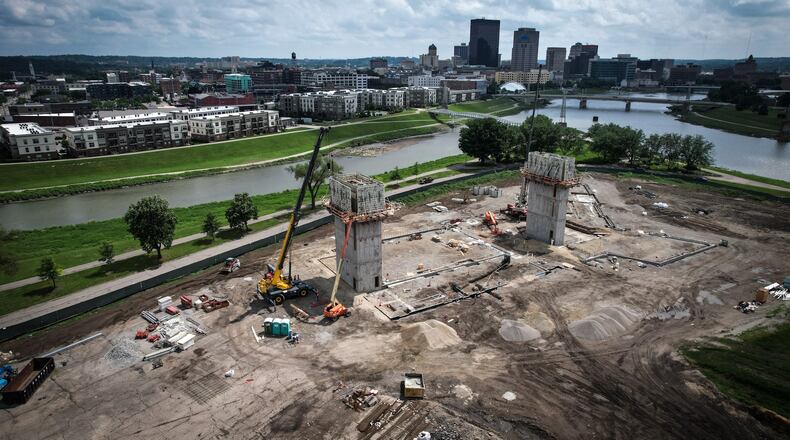The biggest grant on the local list is nearly $3.7 million for cleanup at the intended site of the Greater Dayton School.
“These funds are significant investments in the future of our communities,” Lydia Mihalik, director of the Ohio Department of Development, said in the grant announcement. “By cleaning up these hazardous sites, we’re creating new opportunities for economic growth that will benefit businesses and residents for years to come.”
Brownfields are abandoned or underused properties, often old industrial sites, where possible lingering contamination hinders redevelopment. Identifying brownfields and knowing what sort of contamination is in the dirt, water and air are vital preliminary steps toward reuse of the land.
The state budget passed in June 2021 included $350 million for a new Brownfield Remediation Program through the Ohio Department of Development. Every county got $1 million, with the remaining $262 million available as first-come, first-serve grants.
The state announced $60 million in grants in April. Another $98 million for projects will be announced in the coming months, according to a state news release.
Applications for a third round of grants from any leftover funds will open July 1. In December, DeWine declared brownfields an emergency, speeding up the issuance of grants.
The state funding can pay up to 75% of a cleanup project’s cost, but has to be used within a year.
The latest grant announcements for the Miami Valley area are:
Greene County
· $629,354 for cleanup and demolition of the former Xenia Gas & Light Co. site, which has been vacant since 2004. It is expected to become parking for an adjacent commercial development, part of Xenia’s 118-acre “Hub District” redevelopment plan.
Miami County
· $275,000 for cleanup and demolition of the former S.J. Rudy Grain Elevator and Louis Peters & Co. Tobacco Warehouse. The village of Covington owns the vacant property, and plans to redevelop it as part of the Schoolhouse Park project, which is expected to be finished this year.
Montgomery County
· $823,624 for cleanup, including asbestos removal, from the north wing of the Dayton Arcade, the second phase of the long-vacant landmark’s revitalization.
The nine buildings of the South Arcade are being redeveloped as a mix of housing, commercial and event space. The two buildings of the North Arcade, totaling 87,000 square feet, are expected to house a marketplace, restaurants and “micro-lofts” or hospitality space, according to developers.
Lead developer Cross Street Partners announced in May it plans to invest about $35 million, and is working on financing a 91-room hotel in the North Arcade. The state grant announcement identifies that as a Hilton Garden Inn.
· $264,000 to assess possible contamination at a former wastewater treatment plant in West Carrollton. The 72-year-old plant was built to process water from a paper de-inking mill, according to the grant announcement. Vacant for years, it must be assessed for environmental hazards such as asbestos before demolition. The city plans to redevelop the site as a sports complex, the grant announcement says.
· $3,657,591 for soil and groundwater treatment at Deed’s Point, the confluence of the Great Miami and Mad rivers in Dayton. The site was created after the 1913 Great Dayton Flood by building levees and dredging the rivers. Now it hosts an unused baseball field, parking lot and dog park, but it’s intended to become the site of the Greater Dayton School. The school, backed by area real estate entrepreneur Larry Connor, is to be Ohio’s first private, non-religious elementary school for under-resourced students, according to the grant announcement.
It’s scheduled to open in August with 100 K-3 students; they’ll use a building near Sinclair Community College’s downtown campus until the school building at Deed’s Point is finished next year.
Preble County
· $153,437 for an environmental assessment of the former Hines Truck Stop. Developed as a fuel station 70 to 100 years ago, it shut down in 1990. The assessment will look for contamination from any fuel leaks. Following any needed cleanup, the building will be torn down and the site prepared for redevelopment, according to the grant announcement.
“These properties are vital spaces in our communities, ones that are not only being wasted in their current capacity, but oftentimes are a danger to their local communities,” DeWine said in the news release. “Today, we’re reclaiming these spaces for the future of our residents, businesses, and communities.”
There are brownfields in all of Ohio’s 88 counties. There may be as many as 9,000 statewide, including not just industrial sites but smaller businesses such as former gas stations and dry cleaners, according to the Greater Ohio Policy Center, a nonprofit that promotes urban revitalization.
Currently, the state relies on voluntary reporting to identify brownfields. The state’s list includes 309 sites so far, including eight in Butler County; three each in Champaign, Clark and Greene; one in Darke; two in Miami, 16 sites in Montgomery and one in Preble. At least some of those sites have already been redeveloped into new uses.
Only one of the local sites receiving the latest grants appears to be listed on the state’s database: the former wastewater treatment plant in West Carrollton.
About the Author

